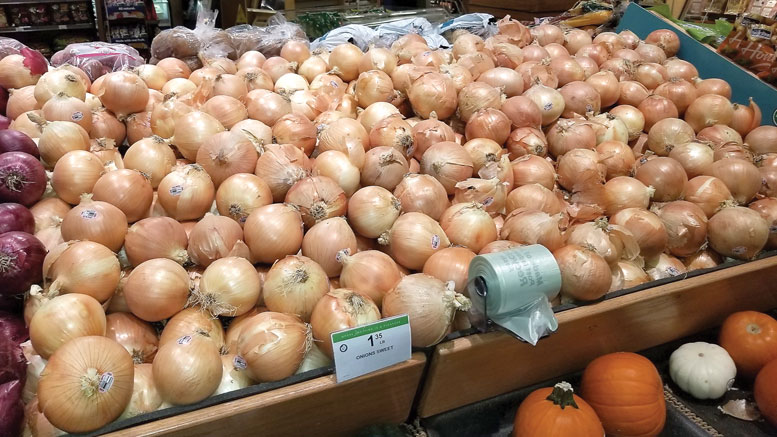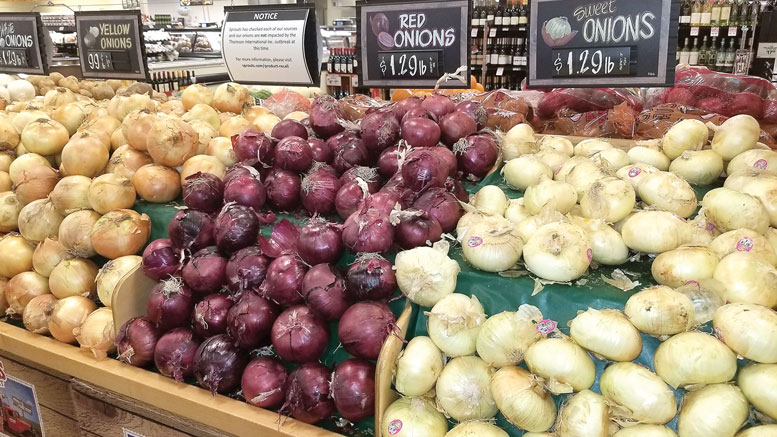Sweet Onions Rev-Up Winter Sales
November 23, 2020 | 8 min to read
Sweet onions have become a year-round staple in supermarkets, fueled by consistent demand, particularly in winter. With imports from Peru bridging the gap after Vidalia shipments conclude, retailers are encouraged to create impactful displays to capture shopper interest. Winter sweet onions not only enhance sales but also attract customers to purchase additional produce items. Proper marketing and cross-merchandising strategies can significantly boost these seasonal sales, ensuring a steady supply meets growing consumer expectations.

Originally printed in the November 2020 issue of Produce Business.
The imported staple item continues to increase register rings.
Sweet onions are an important part of wintertime sales. After Vidalia shipments and other U.S. regions finish shipping sweet onions in early fall, produce executives shouldn’t reduce investment in the sweet onion category.
Winter import onions play a key role in produce aisle sales. Retailers can capitalize on the holidays and sports season to promote and grow sales.
“Imported onions serve the purpose because people still want sweet onions in the winter,” says Sal Selletto, produce manager of the Middletown, NJ-based Food Circus/Foodtown’s Sea Girt, NJ, store. “The demand has really kept up from the summer, with all the grilling in [that season]. We haven’t really seen a drop-off because more people are cooking at home and can’t really go out too much.”
Formerly a specialty item, sweet onions are now a staple of the produce aisle, and shoppers expect them to be available throughout the year.
MUST-HAVE ITEM
“In working with winter sweet onions over the last 30 years, I’ve witnessed them go from a non-factor to something that is a must-have,” says Mark Breimeister, sweet onion specialist for Potandon Produce LLC, in Idaho Falls, ID. “Our numbers for the Green Giant label have been growing steadily since I came onboard to help create a year-round sweet onion program.”
During the winter months, Peru is the dominant sweet onion supplier. Peru shipments typically begin in late August and September, as the Vidalia deal winds down, and continues through late February and early March, when Mexican spring shipments begin ahead of the mid-April Vidalia start.
“Peru’s imported onions are just as important to us as Vidalias,” says Delbert Bland, president of Bland Farms LLC, based in Glennville, GA. “The Vidalias opened the door and created the category, but Peru filled the gap between late summer and early spring. The business is growing every year. The market is expanding.”
“If you build the display, the customers will come. Build key end caps in the same area of the other onions or facing the salad display.”
— Mark Breimeister, Potandon Produce
Winter sweet onions are a key ingredient in supermarket sales, says Jeff Brechler, salesman with Little Bear Produce, based in Edinburg, TX. “For retailers, the winter sweet onions ensure a 12-month supply,” he says. “Imported onions complete the sweet onion cycle, in terms of supply.”
Winter sweet onions are of benefit to supermarket sales. “We believe our RealSweet Peruvian sweet onions are the premium sweet onion that allows retailers to provide the same quality of sweet onion to their consumers 11 months of the year, helping them build sales and consistency in the category,” says John Shuman, president and CEO of Shuman Farms, Inc., Reidsville, GA.
STRONG SHOPPER DEMAND
Winter sweet onions keep the category moving. “Peruvian onions help make availability of year round sweet onions possible,” says Matthew Gideon, sales and commodity manager for Keystone Fruit Marketing, Greencastle, PA. “They (retailers) should source imported sweet onions to bridge the sweet onion gap to ensure sweet onions are in their stores year-round. This will maintain brand category consistency.”
Imported onion sales have been on the uptick in recent years, says Breimeister. “They are important because sweet onions offer a high-margin additional sale that doesn’t take away from other onion sales,” he says. “Additionally, having winter sweet onions on the shelf means the retailer doesn’t need to reset the shelf.”
Depending on the region and market, winter imported sweet onions typically go on ad from 99 cents to $1.49 per pound, says Breimeister. “I believe the winter sweets are just as profitable as the summer sweet onions, but they tend to retail at a higher price, meaning more gross revenue through the register,” he says.
Winter sweet onions are as flavorful as those harvested during the spring and summer. “The consumer base has begun to realize over the years the quality of the Peru sweet onion is excellent,” says Bland. “The taste and flavor profile is very favorable to the Vidalia. People tell me they can’t really tell any difference between the two.”
Shoppers are looking for tasty items in the winter. “Imported sweet onions offer something else during the winter that gives you a little flavor of spring time,” says John Vlahandreas, national onion sales director for Wada Farms Marketing Group LLC, in Idaho Falls, ID. “They get your train of thought stuck in summer and get your mindset toward something different. Anything sweet is summerish.”
HOLIDAY LIFT
With its multiple holidays and events, including Thanksgiving, Christmas, New Year’s and the Super Bowl, sweet onions benefit from the winter holidays. “Of course, the winter is a great time to market sweet onions,” says Breimeister. “We have the key holiday season and sports events like the Super Bowl and March Madness where people are gathering and cooking, although with the pandemic, these gathering could be smaller.”
Retailers should invest in winter sweet onion displays as much as they do during the spring and summer, recommends Bland. “The displays should be similar to the Vidalias, like you see in the Sam’s Clubs and Costcos,” he says. “Their numbers are showing it.”

Sizable displays attract shopper interest. “It’s important to put your best foot forward as you transition from deal to deal,” says Breimeister. “You have one opportunity to make a good first impression with the consumer. If you build the display, the customers will come. Build key end caps in the same area of the other onions or facing the salad display.”
Cross merchandising helps increase sales. “Retailers (should) pair them with different items around them and build meal kits, like what has happened with burger bashes and grilling events,” says Brechler of Little Bear. Those include ground beef, buns, condiments and onions. “There are a lot of cross promotions and a lot of other items involved in the sales,” he says.
To capture additional sales, Shuman recommends positioning winter onions in other areas. “We encourage retailers to cross merchandise sweet onions with other items, such as peppers, tomatoes and potatoes,” he says. “We encourage retailers to build cross merchandising displays in the produce department as well as the meat department to take advantage of these consumer buying habits and drive incremental sales. Sweet onions can also be merchandised outside of the produce department, specifically with turkeys and roasts for the holidays.”
DISPLAYING FOR SUCCESS
Those secondary displays help with register rings. “If you advertise green peppers and feature them together with onions and cooking vegetables, we see good sales,” says Food Circus/Foodtown’s Selletto. The store groups all the onion varieties together in the main display, but also likes to position displays in other store areas. “Onion sales as well as potatoes are strong all year, but demand stays strong during the winter for sweet onions,” says Selletto. “That’s especially true now as many people are cooking at home.”
Retailers should capitalize on rising demand. “Over the past several years, demand for sweet onions has been steadily increasing,” says Keystone’s Gideon. “This demand has been fueled by increased consumer awareness and growing popularity of sweet onions. For a period of time, the available supply of authentic sweet onions was lagging behind the demand. Today, a reliable steady supply of year round authentic sweet onions is available to meet increasing demand.”
Wintertime onions play an important role in consistent year-round sales. “We have a robust marketing and promotional calendar planned through the fall and winter months focused on the versatility and delicious flavor of our premium sweet onions,” says Shuman. “Whether consumers are cooking holiday meals or trying to eat a little healthier come the New Year, sweet onions are a key ingredient.”
Proper timing of ads is also important. “A dollar needs to stretch as far as it can, especially in today’s economy,” explains Brechler. “The more items that can be included in promotions, the more comfortable consumers will be and more appreciative of what it is that’s going on.”
Shoppers who place sweet onions in their shopping carts help lift sales of other produce items. “Based on Shuman’s exclusive consumer purchase behavior and consumption research, when sweet onions are in consumers’ market baskets, they are more likely to purchase fresh beef, tomatoes, potatoes, squash, mushrooms and peppers,” says Shuman.
The typical sweet onion consumer is 55 years of age or older living in a two-person household with annual incomes between $50,000 and $75,000. Shuman’s research also revealed the average consumer eats 1.6 pounds of sweet onions a year.
SELL NO PHONIES
Carrying imported sweet onions is important for supermarkets wanting to sell to shoppers desiring flavorful sweet onions. “If retailers want to have sales as the most that they can, they need to have them,” advises Bland. “It’s a different customer who buys a western globe-type onion. If they don’t have the sweet flat onions from Peru, they will miss that sales opportunity. It’s the difference between completely covering all of your customer base and only partially covering it. There are a lot of people out there that love a sweet onion enough that they will go to another store to get one they’re looking for.”
Retailers should make sure they market real sweet onions. “If you are used to selling quality Vidalia, Walla Walla or 1015-type summer sweet onions, and you put impostor sweet onions on the shelf once fall comes around, odds are the consumer will be turned-off and not return to buy more sweet onions until the domestic spring season onions come around that they can trust in again,” observes Breimeister.
Every year, Little Bear increases its sweet onion acreage in all its growing regions. “Sweet onions have expanded in popularity,” says Brechler. “As a category, sweet onions have been increasing. As our acreage has been increasing year over year, that lends me to believe it’s following consumption.”
Quality is key. “Consumers typically respond to brand recognition, consistently purchasing the highest quality sweet onion brands from only reputable industry leaders,” says Gideon of Keystone. “This is the easiest way for retailers to provide consumers with confidence that they are buying the highest quality, safest, freshest and most flavorful sweet onions.”
Sweet onions haven’t been unaffected by the chaos caused by COVID-19. Brechler notes a change in shopping habits. “Once the U.S. found that middle ground between the two dragons, the onset of COVID and the economy, and learned new habits and new ways of doing things, we saw really strong growth in the consumer packs,” he says. Instead of bulk displays, shoppers preferred the 3- and 5-pound packs. The grab-and-go mentality means fewer shoppers want to remain long in the stores, says Brechler.
A variety of packaging helps spur sales. “We offer a wide variety of packaging options for retailers such as large display bins, consumer bags, display-ready containers, cartons and secondary display bins designed to create meal solution opportunities in the produce department and drive incremental sales,” says Shuman.
3 of 16 article in Produce Business November 2020

